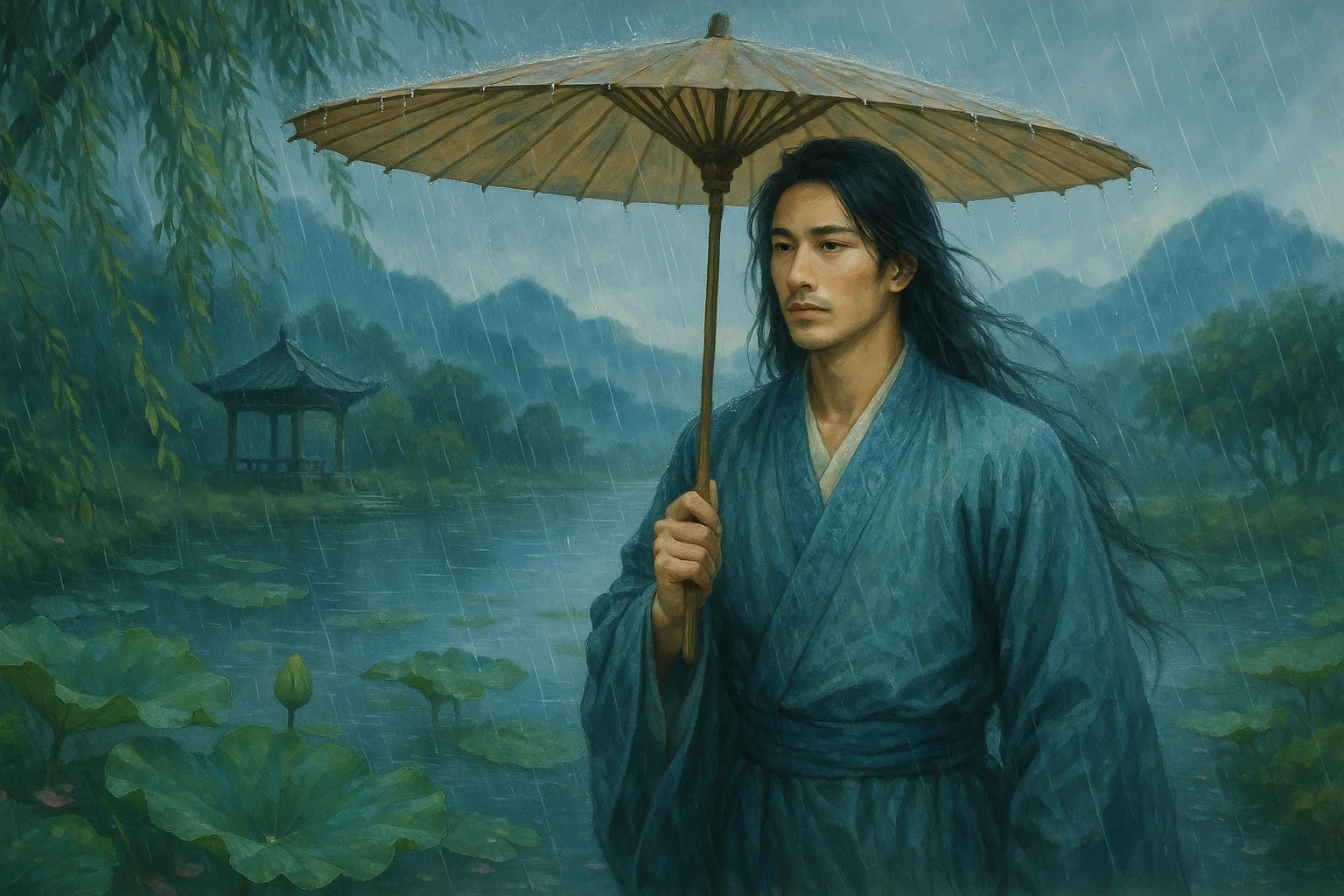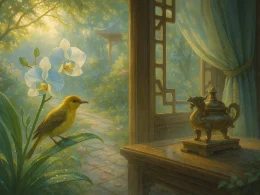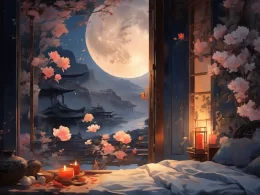Snow mimics mume blooms, mume mimics snow,
Both likeness and unlikeness wondrous show.
Who knows this teasing charm’s deep art?
Ask the moon o’er south tower—she’s wise at heart.
Last year I recall, when seeking flowers,
Old memories now lack tellers for hours.
For whom did I swoon? For whom stay clear?
Still I rue that light farewell of yesteryear.
Original Poem
「踏莎行 · 雪似梅花」
雪似梅花,梅花似雪。似和不似都奇绝。
恼人风味阿谁知?请君问取南楼月。记得去年,探梅时节。老来旧事无人说。
吕本中
为谁醉倒为谁醒?到今犹恨轻离别。
Interpretation
This lyric, composed during the Southern Song Dynasty, exemplifies Lü Benzhong’s signature style—deceptively simple language layered with profound emotion. Through the interplay of snow, plum blossoms, and moonlight, the poet constructs a delicate meditation on memory, regret, and the passage of time. The poem’s structure is meticulously crafted: the upper stanza poses a riddle of resemblance and difference, while the lower stanza unveils the heartache beneath, culminating in a lament for lost love and hasty farewells.
Upper Stanza: "雪似梅花,梅花似雪。似和不似都奇绝。恼人风味阿谁知?请君问取南楼月。"
Xuě sì méihuā, méihuā sì xuě. Sì hé bù sì dōu qí jué. Nǎo rén fēngwèi ā shéi zhī? Qǐng jūn wèn qǔ nán lóu yuè.
Snow resembles plum blossoms,
plum blossoms resemble snow—
alike and unlike, both wondrous.
Who understands this vexing allure?
Ask instead the moon over the south tower.
The stanza opens with a chiasmus—"snow resembles plum blossoms / plum blossoms resemble snow"—creating a mirroring effect that blurs distinctions between the two. Their shared whiteness ("alike") contrasts with their essence: snow’s transience versus the plum’s resilience ("unlike"). This duality is deemed "wondrous" (奇绝), yet it stirs unresolved emotion ("vexing allure"). The moon (南楼月), a silent witness to past intimacies, becomes the keeper of secrets the poet cannot voice directly.
Lower Stanza: "记得去年,探梅时节。老来旧事无人说。为谁醉倒为谁醒?到今犹恨轻离别。"
Jìdé qùnián, tàn méi shíjié. Lǎo lái jiù shì wú rén shuō. Wèi shéi zuì dǎo wèi shéi xǐng? Dào jīn yóu hèn qīng líbié.
I remember last year,
when we sought blossoms together.
Now aged, those memories have no listeners.
For whom did I drunkenly fall? For whom wake?
Even now, I regret our careless parting.
Here, the poet’s restraint collapses into confession. The "blossom-seeking" (探梅) of yesteryear evokes a shared past, now rendered solitary by time ("no listeners"). The paired questions—"For whom did I drunkenly fall? For whom wake?"—lay bare his lingering attachment, the repetition mimicking the cyclical torment of memory. The final line, "I regret our careless parting" (恨轻离别), strikes with the weight of irrevocability, transforming the poem from a musing on nature into an elegy for love lost to haste.
Holistic Appreciation
The entire ci poem begins with a subtle visual/olfactory contrast between plum blossoms and snow. It first sets a scene with questions, using the moon as a witness, then resolves with past memories and regretful closure, forming a structural beauty of "scene before emotion, suspense before clarity." The hazy beauty of the first stanza contrasts with the direct confession of remorse in the second stanza: the scenery is both an object of present appreciation and a vessel for personal memories; the moon is both a natural phenomenon and a witness to emotions. Lü Benzhong excels at weaving deep affection and recollections beneath plain words, allowing the poem to be read both as a crystalline landscape sketch and as a lyrical expression of parting sorrow—restrained yet potent.
Artistic Features
- Novel Imagery, Skillful Contrast
The lines "Snow resembles plum blossoms, plum blossoms resemble snow" construct a unique artistic conception, showcasing their shared purity and beauty while highlighting the nuanced difference between "resemblance" and "dissimilarity." This visual and sensory contrast adds layers to the imagery and poetic ambiguity. - Scene-Emotion Fusion, Emotion Embodied in Scenery
Lü Benzhong skillfully reflects inner feelings through natural elements. Here, the cold purity of plum blossoms and snow refracts the sorrow of separation and the bitterness of longing, achieving a seamless fusion of scene and sentiment that heightens emotional authenticity. - Compact Structure, Lively Rhythm
The two stanzas are clearly structured with natural emotional progression. The first stanza provokes imagination through subtle descriptions and questions, while the second shifts to profound nostalgia and regret. This measured pacing creates intense emotional resonance. - Ambiguous Language, Rich Connotation
The diction is concise yet profound. Phrases like "Who knows this vexing flavor?" convey emotional complexity through understatement, crafting a veiled beauty that invites reflection and rewards contemplation. - Sincere Emotion, Restrained Expression
Rather than stating parting grief explicitly, Lü Benzhong implies melancholy and regret through scenic depictions and emotional hints. This makes the sorrow both profound and subtle, avoiding artifice while amplifying genuine poignancy.
Insights
This ci teaches us that skillful combinations of imagery can deepen themes and enrich emotional expression. By juxtaposing the similar yet distinct natural elements of snow and plum blossoms, Lü Benzhong reveals how seemingly analogous life experiences differ in essence, urging readers to savor subtle distinctions and complex feelings. The poem also reminds us that emotions are often intricate amalgamations—like the "vexing flavor"—that require quiet contemplation to grasp fully. It encourages us to embrace ambiguity and contradiction when facing separation and regret, allowing ourselves to steep in the subtle yet palpable beauty of unresolved feelings.
In our fast-paced, restless modern world, this restrained and profound mode of expression calls us to cherish inner sensitivity and emotional nuance, maintaining clarity and composure amid chaos.
About the Poet

Lü Benzhong (吕本中 1084 - 1145), a native of Shouxian in Anhui, was a renowned poet and Neo-Confucian scholar of the Southern Song Dynasty. As a key theorist of the Jiangxi Poetry School, he proposed the concept of "living method" (huofa), advocating for natural variation within established poetic rules. With over 1,270 surviving poems, his Genealogy of the Jiangxi Poetry School (Jiangxi Shishe Zongpai Tu) established Huang Tingjian as the school's patriarch, profoundly influencing Song poetic theory and serving as a bridge between the Jiangxi School and the Four Masters of the Mid-Song Revival.












